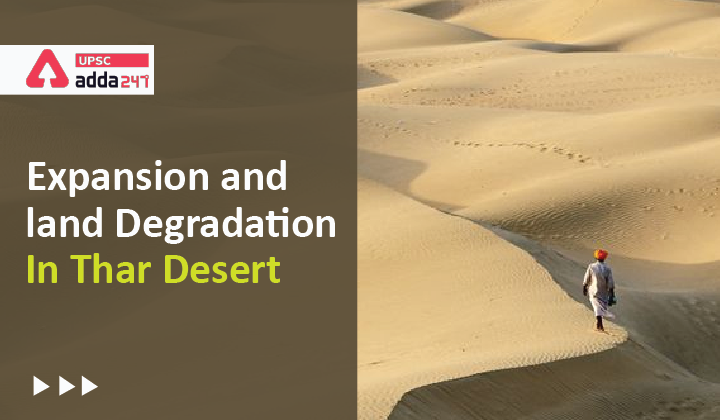Table of Contents
Expansion and Land Degradation in Thar Desert Relevance
- GS 3: Conservation, environmental pollution and degradation, environmental impact assessment.
Expansion and Land Degradation in Thar Desert: Context
- Recently, a study was undertaken within the framework of the UN Convention to Combat Desertification (UNCCD). In this study, the scientists studied the climate and vegetation in Thar, to understand the desertification process.
Expansion of Thar desert
- The study has revealed that Thar desert, the world’s ninth largest hot subtropical desert, is expanding fast.
- Reasons of Thar expansion: migration of people, changes in the rainfall pattern, spread of sand dunes and unscientific plantation drives.
- The scientists have said that over-exploitation of resources had led to reduction in vegetation cover in the areas adjacent to the Thar desert, contributing to its expansion beyond four districts in western Rajasthan.
- In the Thar desert, the degradation of land is posing a threat to the desert ecology, while the climate change has contributed to the spread of arid region.
- With the gradual destruction of the Aravali ranges, the scientists have predicted that the sandstorms from the desert will travel to the National Capital Region (NCR) in the years to come.
Loss of Aravali hills
- Aravali Ranges act as a natural green wall between the desert and the plains.
- They play an important role in the recharge of groundwater and are home to a vast array of biodiversity including many forests and 20 wild life sanctuaries.
- Although Supreme Court, in 2002, banned quarrying in this 10 mile long area of the range, a group of men are working to extract rocks to sell to the construction sector.
Reasons
- However, in the recent past, excavation of the Aravali hills has become a lucrative industry and a way of life in the Aravalis outside New Delhi.
- A 2018 report by the Supreme Court-appointed Central Empowered Committee (CEC) found that 31 out of the 128 hills located in Rajasthan have vanished in last 50 years due to illegal quarrying.
Impact
- Loss of the hills implies a huge loss of biodiversity.
- Disappearance of Aravalis means irreparable damage to the environment.
- The desert sandstorms will travel as far as the NCR, increasing pollution in the already polluted areas.
Steps
- No mechanism has evolved so far to control the spread of sand dunes.
- New plans should be evolved for conservation of the Aravali ranges to stop the desertification towards eastern parts of Rajasthan.
Also Read:





 TSPSC Group 1 Question Paper 2024, Downl...
TSPSC Group 1 Question Paper 2024, Downl...
 TSPSC Group 1 Answer key 2024 Out, Downl...
TSPSC Group 1 Answer key 2024 Out, Downl...
 UPSC Prelims 2024 Question Paper, Downlo...
UPSC Prelims 2024 Question Paper, Downlo...





